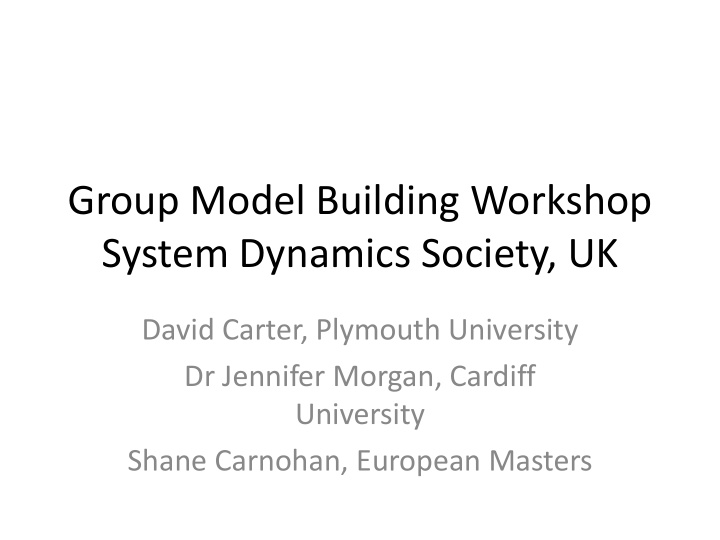



Group Model Building Workshop System Dynamics Society, UK David Carter, Plymouth University Dr Jennifer Morgan, Cardiff University Shane Carnohan, European Masters
Aim and objectives for today • AIM. To explore expanding and collapsing scripts (Hovmand et al, 2012) for use in eliciting data from participants. • OBJECTIVE (I). Investigate aspects of case study development based on concept model. • OBJECTIVE (II). Expand ideas on likely intervention opportunities (pre-break). • OBJECTIVE (III). Collapse towards values associated with learning (post-break).
Background to case • You are a risk audit team for Car co seeking to identify & mitigate recurrent competitor risks based on our stakeholder groups; • Long-term overshoot and collapse of share price following potential company scandal; • Indications that workforce learning suffers when management intervention numbers rise to turn the situation around; • Uncertainty over where/how/if to minimise risk and retain stable and resilient growth; • Proposal to simulate system behaviours to learn about risk assumptions associated with mental models.
CarCo. Initial Concept Model B2 B1
Concept model problem behaviour
Which CarCo policies might break the cycle for attaining the following goals? Where are potential levers associated with 1. Reducing systemic instabilities; 2. Ensuring share price sees steady growth; 3. Eliminating the need for intervention; 4. Raising awareness of workforce development for sustaining profitable returns to investors.
You cooperation is needed • Handout gives further detail (also some copies of the noted press articles previously circulated by email), we now need your risk mitigation policies. • Need 6 groups (max. 6 people/group) exploring – Buying members of the public as stakeholders; – Leaders of change as stakeholders; – Decision makers as stakeholders; – Managers who reinvest the profits as stakeholders; – Worldwide global workforce as stakeholders; – Stock market investors as stakeholders.
Nominal Group Technique for potential policy interventions (3 decision rules/policy 6 people max. and 5 minutes per person) Policy A Policy B Policy C Originator 1 Reviewer 2 Reviewer 3 Reviewer 4 Reviewer 5 No. endorsements 1/2/3/4/5 1/2/3/4/5 1/2/3/4/5 Most endorsed Y/N Y/N Y/N policy
Refreshment Break (30 mins) Condensing scripts after coffee: please take a look at other group solutions posted on the conference walls.
ADD SOME NON EXECUTIVE DIRECTORS (NED) TO BOARD BOARD-LEVEL DECISION BASED ON POLICY ADVICE TO RETAIN SHARE PRICE
Appointing Non-Executive Directors
Your help is needed to quantify additional experience from Non Executive Directors • Keep in previous groups (6 people maximum). • Take a pen and mark 3 positions on your own NED learning curve indicating delays for little, some and considerable amounts of experience in sponsoring new change projects. • Overlay all 6 plots between the folded paper then sketch a line reflecting the majority view. • We collect the sketched lines on paper from all groups to generate a new graphical input device.
VISual CONSensus learning curves 90d 80d 70d X 60d 50d X 40d X 30d 20d 10d 0d DELAY No.4 QTRS(YRS) EXPERIENCE Limited Some Significant LEVEL experience experience experience
Simulating impact of new learning on problem behaviour – what will change?
Your views How does this compare to what you might have expected (what assumptions can we learn from)?
Conclusions • Session explored aspects of car manufacture case based on concept model using this to expand opportunities to intervene before condensing views on learning curves. Scripts therefore work in group model building context. • Scripts are used to elicit data from participants. Condensing ideas takes time but can be informative. Selecting scripts need to consider structure and remember that expanding ideas can be fun. • Simulation models provide “test - beds” for new approaches where top-down social policies are often evaluated using system dynamics (scaling with ease from macro decisions to micro implications for example).
References Carter, D., Moizer, J. and Liu, S. (2013). Using groups to support judgmental parameter estimation VISCONS: ‘Eyeballing’to capture a quantified group consensus. Expert Systems with Applications , 40(2), pp.715-721. Hovmand, P.S., Andersen, D.F., Rouwette, E., Richardson, G.P., Rux, K. and Calhoun, A. (2012). Group model‐building ‘scripts’ as a collaborative planning tool. Systems Research and Behavioral Science , 29(2), pp.179-193. Scriptapedia Version 4.0.6 (accessed 4/4/16) www.systemdynamics.org/conferences/2013/proceed/papers/P1405.pdf Van den Belt, M. (2004). Mediated modeling: a system dynamics approach to environmental consensus building. Island press. Vennix, J.A.M. (1996). Group Model Building: Facilitating Team Learning Using System Dynamics. Wiley: Chichester.
Questions to consider for CarCo What learning delays are associated between specific cause-effect event pairs and who is able to affect these within the concept model system? 1. leadership intervention to regaining share price; 2. share price recovery to reducing learning investments; 3. lower learning capacity to greater loss of share price and; 4. share price losses to further leadership interventions.
Recommend
More recommend